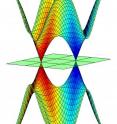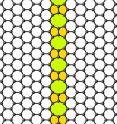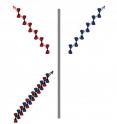NRL researchers take a step toward valleytronics
Related images
(click to enlarge)
Valley-based electronics, also known as valleytronics, is one step closer to reality. Two researchers at the Naval Research Laboratory (NRL) have shown that the valley degree of freedom in graphene can be polarized through scattering off a line defect. Unlike previously proposed valley filters in graphene, which rely on confined structures that have proven hard to achieve experimentally, the present work is based on a naturally occurring line defect that has already been observed. The discovery was published in Physical Review Letters on March 28, 2011 and was also the subject of a separate Viewpoint article in Physics. Information in solid-state, either classical or quantum, is generally carried by electrons and holes. The information can be encoded in various degrees of freedom such as charge or spin. Charge representations, for example the absence or presence of an electron in a quantum dot, are attractive as they are easily manipulated and interrogated through electric fields. The advantage of spin representations, used in the field of spintronics, is their superior shielding from undesired electric fluctuations in the environment, making the information in these latter representations more robust. In the future, there might be a third middle-ground alternative in the valley degree of freedom that exists in certain crystals, including graphene.
The valley degree of freedom in graphene gained attention in 2007 when it was proposed that electrons and holes could be filtered according to which valley they occupy. Unfortunately, the structures required for this and subsequent valley filters are difficult to fabricate, and as a result a valley filter has yet to be demonstrated experimentally. The present study from NRL shows that an extended line defect in graphene acts as a natural valley filter. "As the structure is already available, we are hopeful that valley-polarized currents could be generated in the near future" said Dr. Daniel Gunlycke who made the discovery together with Dr. Carter White. Both work in NRL's Chemistry Division.
Valley refers to energy depressions in the band structure, which describes the energies of electron waves allowed by the symmetry of the crystal. For graphene, these regions form two pairs of cones that determine its low-bias response. As a large crystal momentum separates the two valleys, the valley degree of freedom is robust against slowly varying potentials, including scattering caused by low-energy acoustic phonons that often require low-bias electronic devices to operate at low temperatures typically only accessible in laboratories.
Valley polarization is achieved when electrons and holes in one valley are separated spatially from those in the other valley, but this is difficult to do as the two valleys have the same energies. It was found, however, that this spatial separation can be obtained in connected graphene structures that possess reflection symmetry along a particular crystallographic direction with no bonds crossing the reflection plane. This property turns out to be present in a recently observed line defect in graphene. The reflection symmetry only permits electron waves that are symmetric to pass through the line defect. Anti-symmetric waves are reflected. By projecting an arbitrary low-energy wave in graphene onto its symmetric component, one gets the transmission amplitude through this defect, which is strongly dependent on the valley. Electron and hole waves approaching the line defect at a high angle of incidence results in a polarization near 100%.
There is a long way to go before valleytronics can become a viable technology, explains Gunlycke. The recent advance, however, provides a realistic way to reach a crucial milestone in its development. This research was supported by the Office of Naval Research, both directly and through the Naval Research Laboratory.


